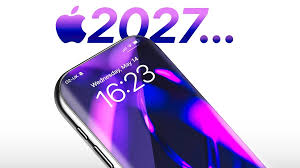Apple’s Roadmap to an All-Screen iPhone: What to Expect from iPhone 17 to the 20th Anniversary Edition
Apple has long been at the forefront of smartphone innovation, and it appears that the tech giant is now preparing to enter its next phase: delivering a truly all-screen iPhone. According to Bloomberg’s well-known journalist Mark Gurman, Apple is laying the groundwork for this ambitious goal with a series of calculated design changes, starting with the upcoming iPhone 17 series and culminating in a futuristic, edge-to-edge display iPhone in 2027 — a release that could coincide with the 20th anniversary of the original iPhone.
Modest Front Changes, Major Rear Redesign in iPhone 17 Series
Set to be unveiled later this year, the iPhone 17 series will reportedly feature subtle updates to the front design, while the Pro models in particular will sport a more significant redesign at the back. Gurman notes in his latest Power On newsletter that Apple is planning a noticeable shift in the rear camera layout, potentially offering a fresh new look for the iPhone 17 Pro and iPhone 17 Pro Max. Meanwhile, the standard iPhone 17 model is expected to maintain the familiar design language seen in the iPhone 15 and iPhone 16 lineups.
These updates may not seem groundbreaking at first glance, but they signal Apple’s strategic shift toward its long-term goal: a seamless, immersive screen experience.
The Gradual Phasing Out of the Dynamic Island
One of Apple’s most defining design features in recent years has been the Dynamic Island — the pill-shaped cutout that houses both the front-facing camera and Face ID sensors. Introduced with the iPhone 14 Pro models, the Dynamic Island has not only been a hardwaraae necessity but also a unique interface feature. However, Gurman reports that Apple is gradually working to eliminate it altogether.
Starting with the iPhone 18 series expected in 2026, Apple plans to relocate some of the Face ID sensors beneath the display. This would result in a slimmer version of the Dynamic Island, with only a small hole-punch cutout remaining for the selfie camera. This intermediate step serves as a bridge to Apple’s ultimate objective — an all-screen iPhone without any visible cutouts or bezels.
The Vision for 2027: Apple’s First True All-Screen iPhone
Looking further ahead, 2027 is poised to be a landmark year for Apple. Not only will it mark two decades since the launch of the original iPhone in 2007, but it may also usher in the debut of Apple’s most advanced iPhone ever. Gurman reveals that Apple is working on a special anniversary edition of the iPhone that will feature a truly edge-to-edge display with no visible sensors or camera cutouts.

This model is rumored to include:
- Under-display Face ID sensors
- An under-display front camera
- A new curved glass design
- A sleek, futuristic aesthetic exclusive to Pro models
If realized, this would represent one of the most significant visual and functional overhauls in the iPhone’s history. The seamless integration of under-display technology would allow for a cleaner, more immersive viewing experience, transforming how users interact with their devices.
“Liquid Glass” UI: A Software Revolution to Match the Hardware
The hardware advancements aren’t the only thing Apple has in the pipeline. The 2027 iPhone is expected to ship with iOS 26 — a version that may introduce an entirely new design language known as “Liquid Glass.” According to Gurman, this updated UI, along with the upcoming macOS 26, will focus on fluid animations, enhanced transparency, and a more intuitive user interface, offering a unified visual identity across Apple devices.
This level of coordination between software and hardware has always been one of Apple’s strengths. If “Liquid Glass” does come to fruition, it will serve as the perfect complement to the new edge-to-edge, curved display design — reinforcing Apple’s focus on delivering a fully integrated, next-generation user experience.
Apple’s Cautious Approach to Innovation
While companies like Nubia have already released smartphones with under-display cameras, Apple continues to take a more cautious, iterative approach. The company is known for refining technology until it meets their high performance and quality standards. Therefore, while these changes are highly anticipated, it’s important to remember that nothing is confirmed until official announcements are made.

Apple’s timeline suggests a clear and deliberate strategy: take progressive steps toward removing display obstructions while ensuring performance and user experience are not compromised. Each update from iPhone 17 to iPhone 18 and finally to the 2027 model represents a calculated move in that direction.
Apple is on the cusp of a transformative shift in smartphone design. With the iPhone 17 introducing incremental changes, and the iPhone 18 and 2027’s anniversary model promising more radical innovations, users can look forward to a truly all-screen iPhone experience. If Mark Gurman’s predictions hold true, the next few years could redefine what we expect from the world’s most iconic smartphone.
Stay tuned — Apple’s 20-year iPhone celebration might just deliver the future of mobile technology.


[…] Apple Developing Under-Display Face ID, All-Screen iPhone for 2027 Anniversary […]